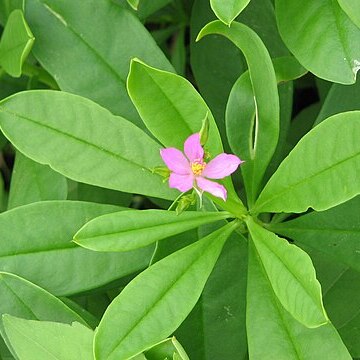Sep 2, caducous; pet 5 (rarely more), distinct, fugacious; stamens 4–45, distinct; filaments slender; ovary ovoid; styles partly or wholly united; capsule 1-celled, many-seeded; seeds cochleate, flattened, minutely roughened; glabrous, succulent, annual or perennial herbs with conspicuous fls in long-peduncled bracteate cymes. Our spp. have a short taproot that in age becomes multicipital, producing from each crown a short stem that has numerous crowded, succulent, terete lvs 3–8 cm, and is prolonged above into a slender scape cymosely branched above and bracteate at the nodes; bracts triangular, 2–5 mm, prolonged backward at base; fls pinkish to deep rosy-red, open for only a few hours in full sunshine; midveins of the capsule-valves often persistent, as well as the placentas; seeds gray over black, 1 mm wide, minutely roughened. 30+, mostly warm N. Amer.
Rather succulent perennial herbs or subshrubs, often arising from an underground tuber. Leaves alternate or rarely subopposite or in a basal rosette, fleshy, flat or terete. Flowers pedicellate in terminal or axillary cymes or thyrsiform panicles, sometimes raceme-like or reduced to a single flower, bracts and bracteoles small, scale-like. Sepals falling with the petals or subpersistent. Petals mostly 5, free or connate at the base. Stamens indefinite, few to many, free or adherent to the base of the petals, filaments filiform. Ovary superior, multiovulate, style slender, disarticulating at maturity, stigma 3-branched. Fruit a 3-valved capsule, also circumscissile at the base, the valves falling separately, cartilaginous. Seeds many, reniform to lenticular, testa smooth or ornamented.
Herbs, subshrubs or shrubs, often succulent and with fleshy tuberous roots. Leaves alternate (or subopposite), fleshy, entire, flat or terete, petiolate; stipules absent. Inflorescences a terminal or axillary raceme, panicle or cyme, or the flowers solitary and axillary. Sepals 2, free, caducous; petals 5, free or united at base, falling off rapidly; stamens 5-30, arranged in fascicles; ovary superior, sessile or short-stipitate, ovules numerous, basal, style 1, filiform, 3-branched at apex Fruit a 1-locular, loculicidally 3-valved capsule, splitting from apex to base, chartaceous; seeds numerous, flattened, orbicular to reniform, shining, with evanescent aril, embryo incompletely annular; testa smooth, striate or tuberculate.
Herbs, subshrubs or shrubs, often succulent. Leaves alternate or approximate, terete to plane, fleshy; estipulate. Inflorescence terminal or rarely axillary, paniculi-form, cymose or the flowers solitary. Sepals 2, opposite, deciduous or rarely persistent. Petals 5, rarely more, connate at the base or free, deciduous. Stamens 5-30, in antipetalous fascicles. Ovary superior, sessile or short-stipitate, the ovules numerous, the styles 3, more or less united, filiform. Capsule loculicidal, 3-valved, splitting from the apex to the base, chartaceous; seeds reniform-round, numerous, the embryo incompletely annular, the testa smooth, striate or tuberculate, distinctly or indistinctly strophiolate.
Herbs annual or perennial, or subshrubs, often with thick roots. Stems erect, glabrous; axils naked. Leaves alternate or partly opposite, sessile or shortly petiolate, flat. Inflorescence terminal or rarely axillary, a thyrse or panicle, very rarely flowers solitary. Sepals free or shortly connate at base, caducous. Petals 5(-10), free. Stamens 5-30, usually adnate to base of petals. Ovary superior. Stigma (2-or)3-lobed. Capsule 3-valved, often recurved, globose, ovoid, or ellipsoid. Seeds glossy black-brown or black, subglobose or oblate, orbicular-reniform, tuberculate or ribbed, with pale caruncle.
Herbs or semi-shrubs (in Malesia glabrous). Leaves spirally arranged (the lower-most sometimes opposite), linear to obovate. Flowers in terminal whether or not corymboid thyrsi, or cymosely arranged, seldom axillary or solitary. Sepals mostly caducous. Petals mostly 5. Stamens 5-∞. Ovary superior; style mostly with 3 arms. Fruit globular; mostly 3-valved or irregularly caducous.
Seeds reniform or lenticular, often black or greyish and somewhat compressed; testa smooth or variously tuberculate, pitted or ridged, with a distinct hilum; embryo annular.
Capsule chartaceous, 1-locular, many-seeded, opening by 3 valves (6-valved in one species outside our area).
Leaves alternate or rarely subopposite or rosulate, somewhat succulent; stipules absent.
Ovary superior, 1-locular, multiovulate; style filiform, with 3 stigma lobes.
Flowers in terminal or axillary cymes, racemes or panicles, rarely solitary.
Petals 5 (at least in our species), free or joined at the base.
Perennial herbs or shrubs.
Sepals 2, opposite.
Stamens 5-?.

